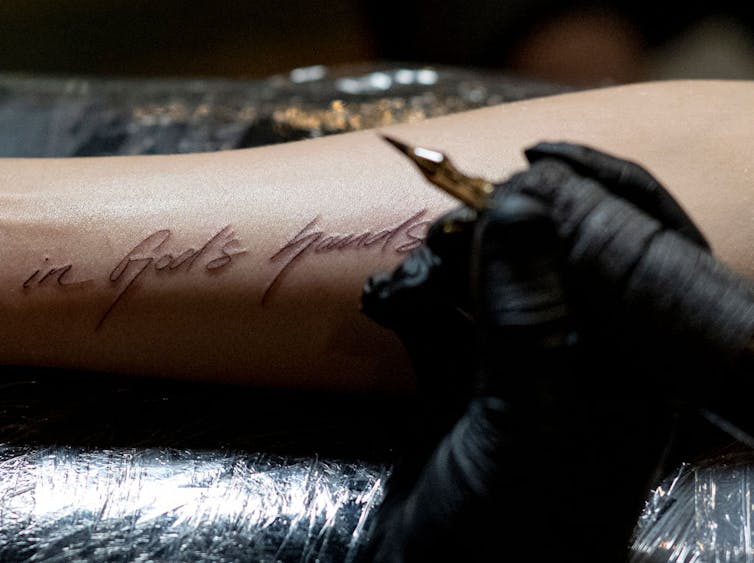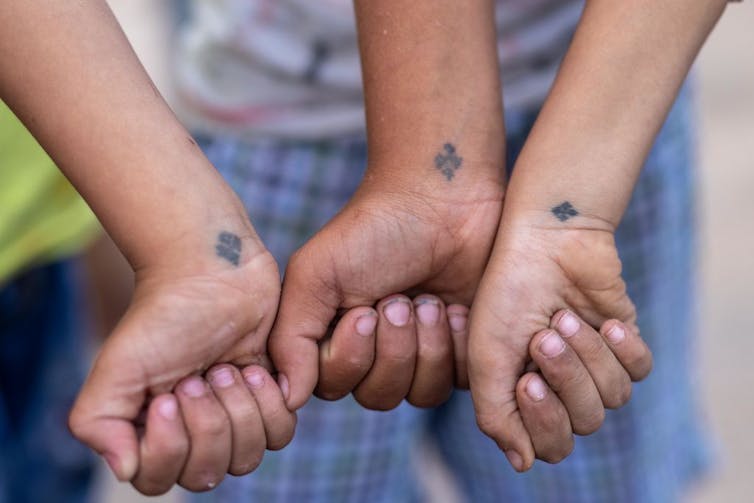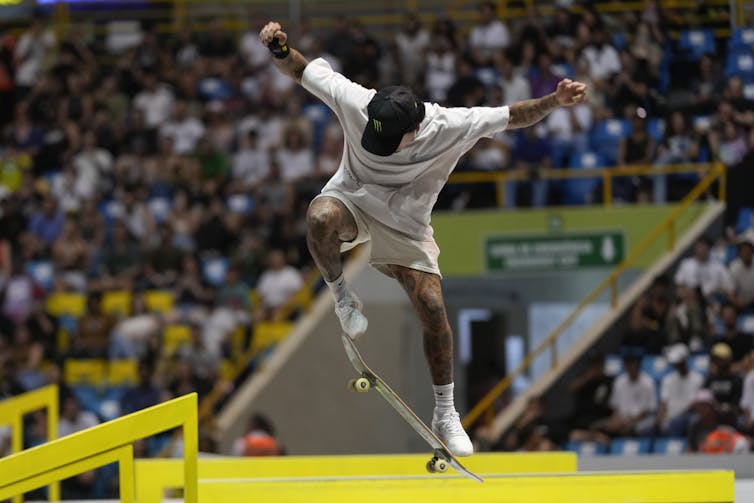
This has been a wonderful summer if you follow sports: tennis championships, end-of-season tournaments and soccer’s European Championship and Copa America – all leading up to the most global event of all, the Olympics.
The Olympic Games began as a religious celebration in ancient Greece, with competitions to honor their gods. But the Olympics declined once the Roman Empire replaced Greek power in the Mediterranean; the final blow came from the Christian Emperor Theodosius I, who saw the Games as a stage for paganism.
At the end of the 19th century, the modern iteration of the Games began – minus religion. This time, they were secular, with flags and patriotism replacing religious worship.
But religion is still easy to see at the Games today, including right on the athletes’ bodies.
At the Summer Games, in particular, lots of skin is on display, and many athletes use it as a testament to faith. There’s Anthony Davis – usually playing for the NBA’s Los Angeles Lakers – with a cross and praying hands across his forearm. Fellow basketball pro Jayson Tatum, of the Boston Celtics, has a collection of religious tattoos, including “God’s will” and “Proverbs 3:5-6” across his back.
As a scholar of religion who writes about tattoos, I’m often asked whether Christianity disapproves of tattoos. According to the Bible, didn’t God reject them?
The answer is not so simple.

Biblical ban?
The first problem in exploring the history of tattoos, religious or not, is what to call them.
Before the European explorers’ voyages to the Pacific in the 18th century – where they encountered Maori facial tattooing, known as “ta moko” – there was no specific word for tattoos in Western languages. Latin, Greek and their derivatives used words that can have many meanings, such as “mark” or “letter.” When the word “tattoo” appears in English versions of Jewish and Christian scriptures, it is more of an interpretation than an exact translation.
Regardless of what you call body modifications, the Hebrew Scriptures suggest that the people of Israel initially despised them, including tattoos and ear and nose piercings. In Leviticus 19:28, God prohibits mourners from funeral rites that involve self-mutilation to honor the dead – the Bible’s only explicit prohibition of tattoos.
More broadly, this rule appears amid a list of forbidden activities meant to differentiate the Jews from other groups of people and their gods. In some cultures of the ancient Middle East, tattoos had a religious meaning, such as being used in fertility and funeral rites. The author of Leviticus seems to be saying, “If what you want is God’s protection, do not get haircuts, shaves or tattoos.”
Saved by the ‘X’
However, many other texts in the Bible have a more favorable view of bodily markings, including decorations like earrings. In the Book of Ezekiel, for example, God instructs the prophet to mark an “X” on the foreheads of pious people in Jerusalem so that they may be saved from the slaying of the unrighteous ones.
In one of the prophet Isaiah’s visions, during the Jewish exile in Babylon, he prophesies, “One shall say, ‘I am the LORD’s,’ another shall be named after Jacob, and this one shall write on his hand, ‘The LORD’s,’ and receive the name Israel.” This verse seems to invoke the Babylonian custom of tattooing servants. Similarly, Isaiah is portraying Jews as loyal servants of the Lord, with no other master.
Another text from the Book of Isaiah describes God himself as tattooed, out of love for his people: “See, upon the palms of my hands I have engraved you; your walls are ever before me.” Faithful to Israel, God has tattooed the walls of Jerusalem on his hands – a reminder of his abiding love for the holy city.
The first Christians
Tattoos were not uncommon during the early days of Christianity. The Roman Empire used them to brand some enslaved people and convicts, including persecuted Christians.
There is no prohibition on tattoos in the New Testament. Around A.D. 50, St. Paul wrote, “Let no one make troubles for me; for I bear the marks of Jesus on my body.” While most biblical scholars accept the text as a metaphor of Paul’s suffering for Christ, some think it refers to the tattoo of a cross. Paul is “reversing” the power of the tattoo: transforming something degrading to a sign of membership and pride.

There are records of Christians tattooing themselves with signs of their faith, including the image of a fish, one of the first Christian symbols. Christians in Syria and Egypt, who began tattooing crosses during the Roman Empire, continue to do so today. Some Eastern Orthodox churches, such as Egyptian Coptic and Ethiopian Christians, incorporated cross tattoos into baptism.
Constantine I, the first Roman emperor to convert to Christianity, established in 316 that a person condemned to gladiator school or to labor in the mines should not be tattooed on the face, but on the hands or calves. His edict reflected a Christian belief that the face reflected the image of God and should not be damaged. Evidently, the problem was not the tattooing itself, but the location.
Sacred systems
Among Olympic athletes – our contemporary gladiators – tattoos still say something. Each one is a meaningful investment of skin, time and money. And they cover part of their bodies: the tools athletes use to compete, and the vehicles for their passion.

Skateboarder Nyjah Huston, for example, sports more than 130 tattoos. Among them, one on the left of his stomach says “Blessed” with praying hands; there is a hamsa, a palm-shaped symbol popular in many Jewish and Muslim cultures, on his right index finger.
Of course, many Olympic tattoos are not religious in a traditional sense. However, they do represent what is sacred or meaningful for these athletes. Their significance depends on both design and location – such as whether they are easy for passersby to see, or more private. Swimmer Caleb Dressel’s elaborated tattoo of an eagle on his left shoulder – inspired by the book of Isaiah – is visible at all times he is competing.
Not all tattoos have such significance, but for many, ink is a way to communicate what is sacred to them – another item to look for while enjoying the Olympics.
Gustavo Morello does not work for, consult, own shares in or receive funding from any company or organization that would benefit from this article, and has disclosed no relevant affiliations beyond their academic appointment.
This article was originally published on The Conversation. Read the original article.







